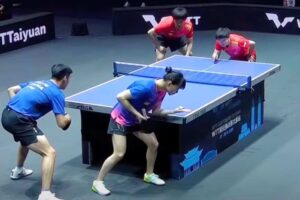When choosing ping pong balls, players often notice stars on them, but what do these stars on ping pong balls mean? For enthusiasts and professionals alike, understanding the significance of these stars is crucial.
These ratings, typically ranging from one to three stars, indicate the quality, durability, and performance of the balls. A higher star rating often means better material and superior playability, essential for competitive matches.
Our exploration delves into unraveling the mystery behind these stars, providing a comprehensive understanding of their role in the world of table tennis.
Understanding the Stars on Ping Pong Balls Mean
The star rating system in ping pong balls, denoted by 1 to 3 stars, defines their quality. This industry-standard categorization signifies the ball’s performance and suitability for play. Three-star balls, meeting the highest standards, are approved for official competitions, ensuring optimal bounce and durability. This is when three-star ping pong balls come into play.
In various industries, stars commonly symbolize quality and excellence. In the context of ping pong, this symbolism aligns with the stringent quality control and durability associated with higher star ratings.
The Star Rating on Ping Pong Balls
Ping pong balls come with star ratings, typically ranging from 1 to 3, to indicate their quality and performance. These stars are visibly marked on the ball’s surface.
A 1-star rating suggests the ball is suitable for recreational play and beginners. A 2-star ball is designed for intermediate play, offering better control and durability. The 3-star balls are crafted to meet rigorous standards, making them the preferred choice for official competitions due to their superior spin, speed, and consistency.
This rating system has a long-standing tradition in table tennis, ensuring that players can rely on the quality and performance of the balls over time. By understanding the star ratings, players can select the right ball to match their playing style and the level of competition.

Interpretation of Ping Pong Ball Stars
A 1-star ball is entry-level, suitable for casual play. 2-star balls offer better performance, while 3-star balls meet the highest standards, ideal for official competitions. Star ratings correlate with key attributes like spin, speed, and control.
The stars on ping pong balls mean different levels of quality and performance, with more stars indicating higher standards. 3-star ping pong balls, meeting stringent standards, provide superior performance compared to their 1 and 2-star counterparts.
The stars on ping pong balls mean that balls used in official competitions are required to be 3-star rated, ensuring fairness and consistency in play. Understanding what the stars on ping pong balls mean can help players select the appropriate ball for their level and needs.
1-Star Ping Pong Balls: A Comprehensive Guide
(i) Characteristics and Attributes: 1-star ping pong balls are entry-level, often made of standard materials like celluloid or ABS plastic. They may lack the advanced features found in higher-star-rated balls, resulting in lower durability and consistency. When it comes to plastic balls, are commonly used in recreational play due to their affordability and suitability for casual games. On the other hand, celluloid balls, while less common nowadays, were historically popular in table tennis and are known for their unique playing characteristics.
(ii) Usage: Primarily used for recreational play, 1-star balls are suitable for casual games and practice sessions. They are commonly found in family settings and beginner-level tournaments.
(iii) Limitations and Considerations: Due to their basic construction, 1-star balls may have uneven bounce and reduced spin. Players seeking higher performance should opt for 2 or 3-star balls.
2-Star and 3-Star Ping Pong Balls Mean
(i) Description and Specifications: 2-star and 3-star ping pong balls are distinguished by their quality and performance. 2-star balls meet basic standards, while 3-star balls, the highest rating, undergo rigorous testing for consistency, roundness, and bounce.
(ii) Advantages in Competitive Play: Higher star ratings signify superior attributes, offering players increased spin, speed, and control. In competitive settings, 3-star balls are preferred for their reliability and consistent play, enhancing the overall gaming experience.
(iii) Quality Control and official ITTF Approval: Both 2-star and 3-star balls undergo stringent quality control, ensuring they meet International Table Tennis Federation (ITTF) standards. ITTF approval ensures adherence to regulations for official competitions.
Understanding Cost Implications of Star-Rated Ping Pong Balls
Ping pong balls are categorized into 1-star, 2-star, and 3-star ratings. Generally, 3-star balls, meeting higher quality standards, tend to be more expensive than 1-star balls. The price discrepancy reflects the varying levels of material quality, manufacturing precision, and performance.
While 3-star balls offer optimal performance, players often balance their choice with budget constraints. 1-star and 2-star balls, being more budget-friendly, are suitable for casual play and practice, providing a cost-effective option without compromising the basic playing experience.
For competitive play and professional training, investing in 3-star balls is recommended due to their superior attributes. In recreational settings or practice sessions, where budget considerations play a significant role, 1-star and 2-star balls are practical choices.

Understanding Real-World Applications of Star-Rated Ping Pong Balls
Choosing the right star-rated ping pong ball is crucial for enhancing gameplay. Players at different levels benefit from specific star ratings 1-star for beginners, 2-star for intermediate players, and 3-star for advanced and competitive play. This ensures an optimal balance of performance and durability.
The star rating influences the ball’s response to environmental conditions. In humid environments, higher star ratings (2-star and 3-star) with better quality materials maintain consistent performance, while 1-star balls may be more susceptible to atmospheric changes.
Players often share experiences online, offering valuable insights into the performance of different star-rated balls. Beginners may appreciate the durability of 1-star balls for practice, while advanced players highlight the precision and consistency of 3-star balls in competitive settings.
Debunking Common Myths about Stars on Ping Pong Ball
(i) Dispelling Misconceptions: Contrary to popular belief, the number of stars on ping pong balls does not signify the quality of play alone. The star ping pong ball ratings (1-star, 2-star, and 3-star) primarily indicate the ball’s precision, consistency, and durability, meeting the International Table Tennis Federation (ITTF) standards.
(ii) Clarifying Suitability: Understanding when and where each star-rated ball is suitable is crucial. 1-star balls are ideal for recreational play, 2-star for training, and 3-star for competitive matches. Dispelling the myth that higher stars guarantee better play in all situations.
(iii) Practical Guidance: Choosing the right ball involves considering skill level and purpose. Beginners benefit from 1-star balls for control, while advanced players prefer 3-star balls for precision. Training sessions often use 2-star balls to balance performance and cost.
In Closing
In summary, understanding what stars on ping pong balls mean can significantly enhance your playing experience. The star ratings, which reflect the ball’s quality and performance, guide players in selecting the best equipment for their needs. Higher star ratings usually promise better durability and consistency, crucial for competitive play.
By choosing the right ping pong balls, players can ensure they have the optimal tools to improve their skills and enjoy the game to its fullest. This knowledge not only boosts confidence but also elevates the overall playing experience. So, next time you purchase ping pong balls, remember the stars are not just symbols but key indicators of quality and performance, helping you make the best choice.










